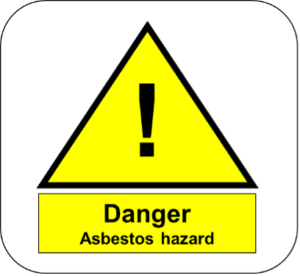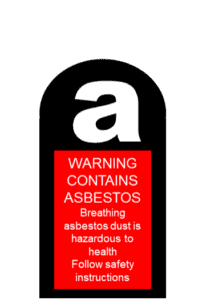Asbestos identification process
Control Measure Knowledge
Asbestos can be found in industrial or residential buildings constructed or refurbished before 2000. A building, or part of a building, constructed or refurbished since 2000 is unlikely to contain asbestos as the importation, supply and use of all asbestos has been banned in the UK since 1999.
The presence of asbestos-containing materials (ACMs) at an incident does not automatically mean that it will present a hazard. The following three-step asbestos identification process will inform the risk assessment:
- Step 1: Are ACMs present?
- Step 2: Can asbestos fibres be released or disturbed?
- Step 3: Do emergency responders need to enter the hazard area?
If there is any doubt as to whether ACMs are present, the incident commander should consider requesting the attendance of a hazardous materials adviser or subject matter expert. Their support should improve the asbestos identification process and risk assessments, and they may be able to arrange for analysis of suspected ACMs. For more information refer to the Health and Safety Executive website for Sourcing professional advice and services on asbestos issues.
The fire and rescue service should consider identifying sources of specialist advice or assistance for dealing with incidents involving asbestos. They should maintain a directory of any specialist advisers and know how to request their advice or attendance.
Step 1: Are ACMs present?
Generic: Sources of information that may be available to establish the presence of ACMs include:
- Asbestos hazard signage
- Visual appearance of construction elements or materials, such as asbestos cement roofs or insulation on pipework
- Operational intelligence, such as is gained through:
- Risk information visits
- Fire safety inspections
- Operational intelligence
- Site training and exercises


Figure: Examples of asbestos hazard signage
For buildings: Sources of information that may establish the presence of ACMs include:
- The duty holder or responsible person for the building for:
- Premises asbestos management plan
- Asbestos survey
- Asbestos register
- Construction workers for buildings under construction or demolition
- Information about the age of:
- The building
- Any refurbishments
- Construction materials
- Knowledge of building stock; the local authority building control department may be able to assist
- Information gained through multi-agency sharing agreements, relating to licensable work involving asbestos
Although information gained about the building, such as its age, or the visual appearance of construction materials may support the risk assessment process, this should not be relied on as the only evidence for the absence of ACMs.
For vessels: Sources of information that may be available to establish the presence of ACMs include:
- The master of the vessel
- Port authority
- Harbour master
- Marine Accident Investigation Board (MAIB)
For rail vehicles: Sources of information that may be available to establish the presence of ACMs include:
- The rail operator
- Rail Accident Investigation Board (RAIB)
Step 2: Can asbestos fibres be released or disturbed?
Once the presence, or suspected presence, of ACMs has been established, the next step of the identification process is to determine the risk of people inhaling asbestos fibres.
ACMs should be assessed and ideally visually examined to determine their condition and therefore the likelihood that fibres or composite particles can be released into the air. This includes scenarios where:
- There are damaged or broken boards or sheets of unknown composition
- Suspected or known ACMs have been damaged, perhaps by debris
- There has been a degradation of bonding, such as weathering.
There is a lower hazard for ACMs with a strong bonding material, such as asbestos cement sheeting. This contrasts with other high hazard ACMs, such as sprayed coatings and lagging, which generally have a greater, more hazardous fibre content and are loosely bound; these may release fibres relatively easily if damaged or disturbed.
If ACMs are disturbed or involved in fire, it is recommended that they are categorised by the level of hazard and designated as:
- Lower hazard – examples include:
- Asbestos cement products
- Asbestos reinforced textured coating (Artex)
- High hazard – examples include:
- Asbestos coatings
- Asbestos insulating boards
- Asbestos insulation
For more information about the applications of asbestos and their categorisation refer to Foundation for hazardous materials – Asbestos hazard levels.
It should also be ascertained whether the ACM has been mechanically altered, such as by cutting, sanding or being broken up, as this will release asbestos dust, fibres or composite particles. The risk of releasing fibres is lower for work with hand tools than powered tools.
There may also be occasions where asbestos dust, fibres and composite particles have been released prior to the arrival of the fire and rescue service. If this may have happened, the quantity of ACMs involved and the likelihood of disturbing the fibres should be assessed.
As asbestos fibres are extremely small and light, they are not visible to the naked eye, and it can be difficult to detect them without specific atmospheric sampling equipment. However, any disturbance of asbestos will release dust and fibres. The extent of fibre release may not be visible, but it will generally reflect the amount of dust or composite particles created. The greater the extent of destruction and the greater quantity of asbestos material, the greater the extent of dust and fibre release. Dust and fibres will generally disperse fairly quickly if there is unrestricted air movement. It is highly unlikely that this will appreciably increase the normal background level of fibres.
The risk of fibres being present above background levels will be lower if ACMs are in the open air, as opposed to ACMs releasing fibres inside buildings, vessels or rail vehicles.
Step 3: Do emergency responders need to enter the hazard area?
The hazard area is where asbestos fibres or composite particles could be airborne, or made airborne by the activities being carried out. If emergency responders do not need to enter the hazard area, the risk of inhaling fibres is eliminated.
A risk assessment should be carried out to determine whether emergency responders need to enter the hazard area. If deployment into the hazard area is required, a safe system of work for asbestos must be followed.
